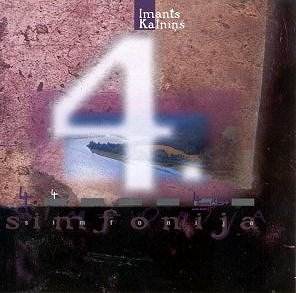Kalnins strikes a mechanistic stance with his motor-rhythmic
crescendo at the start of the allegretto. Having risen to a climactic
statement that pulse rhythm (which returns in the vehemence of the finale)
is caught up by a drumkit over which a Boléro-like lonely
clarinet theme is played. This is developed over that insistent pulse
with repetitive minimalistic elements - notable among these is the French
Horns' triple-accented cell.
The music has the mesmeric 'draw' of Valentin Silvestrov's
Fifth Symphony (try BMG-Melodiya and Sony). I can imagine the conductor
Dzanzhug Khakidze making hay with this work. The whole of the first
movement might be said to be a tribute to Ravel's Boléro though
musically richer. The second movement is a lovely andante tranquillo
of the musette/sleighride variety with much use of percussion (rather
like Shostakovich 15 though even more accessible) with a poignant cry/scream
for the piccolos and a repeated Tchaikovsky-out-of-Shostakovich sigh
for the violins. The Grave molto's brassy address is part-Tchaikovsky
4 and part-Shostakovich 10 melting into a sentimental quicksilver theme
like an austere take on Elizabethan Serenade. It comes as a shock
that the last movement (like Mahler 4) features a vocalist. Pattie Cohenour
has a populist quality of voice meeting on the boundaries of the operatic
diva and grand Broadway. Parallel voices might be Cathy Berberian, Elizabeth
Montgomery and Cleo Laine. She is affecting, gutsy, tender and angry,
phantasmal. The words speak of a love affair run to decay and sadness.
The work might well merit description as a sort of
minimalist symphony - Reich out of Shostakovich out of Sondheim. I find
it completely irresistible and so will you if you like Nyman, Silvestrov,
high-art Broadway, Berio's Folk-Songs and pop culture transformed into
something 'rich and strange'.
The orchestral sound is lively and resonant like a
golden age Melodiya recording of Khachaturyan. This is a concert performance
with the odd shuffle and cough (not many) and I am sure that after hearing
the disc you will end up wishing you had been there.
There are at least five other symphonies and I want
to hear them!
The very brief notes are in Latvian only.
Rob Barnett
NOTE
My good friend Maris Kristapsons has provided the following additional
background:
When Kalnins wrote the work in the early '70s, he was
in the throes of a passionate romance with an American poet/writer named
Kelly Cherry. The text he used in the Symphony is one of her poems.
When it came time to premiere the work, the Communist authorities were
not pleased and forced him to rewrite the movement purely instrumentally,
and suppressed any mention of its true origin. It was not until 1998
or so that the original version was finally premiered as Kalnins intended
it. Long before then, however, the romance had soured.
I never cared much for the work in its purely instrumental
form, but with the vocal finale it makes much more sense and I've come
to appreciate it more. I also feel that the Latvian CD of the premiere
is superior to the BIS version. Kalnins' 6th Sym was premiered last
August. It's over an hour long, with choral passages in the 2nd &
4th movements. The first 3 movts didn't strike me particularly, but
the finale was devastating -- the first time I heard it, after it was
over, I just sat for a while, overwhelmed.
AVAILABILITY
www.balticshop.com
See also Latvian
sampler


